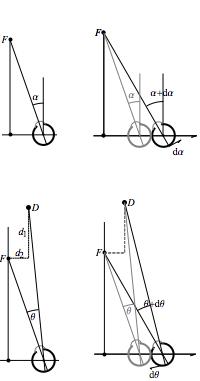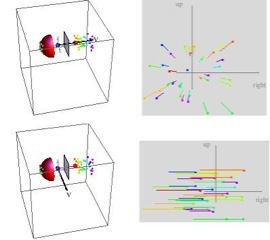Visual Depth Perception
from
Retinal Motion and Smooth Eye Pursuit
Visual Depth Perception
from
Retinal Motion and Smooth Eye Pursuit


Orthogonal Cases of Optic Flow
Straight ahead vs Lateral
Mathematical Retinal Motion and Pursuit
for Lateral Translation in the Fixation Plane
General 3D Motion/Pursuit Theory
We do not yet have a finished 3D Motion/Pursuit theory for arbitrary motion. There are some sample movies of optic flow in more general cases.
Observations in the Fixation Plane for Lateral Translation
Visual perception of depth from lateral observer translation uses both retinal image motion and eye movement. In Nawrot and Stroyan (Vision Res 49:1969–1978, 2009) we showed that the ratio of the rate of retinal motion over the rate of smooth eye pursuit determines depth relative to the fixation point in central vision. Here we analyze the motion/pursuit cue mathematically for the case when objects are distributed across the horizontal viewing plane beyond central vision. This analysis provides a computational foundation to analyze the dynamic geometry of future experiments.
Details of the 2D Theory: Stroyan and Nawrot ( J. Math. Biol. (2012) 64:1157-]1188, DOI 10.1007/s00285-011-0445-1)
Structure from M/P
An Animation of the Postions of Points on a Physical Shape Computed at the Maximum M/P Formula
At a fixed time (position) the motion/pursuit ratio only determines the relative depth of points beyond a fixate when the distractor is in line with the eye and fixate. However, the motion/pursuit ratio is a time-varying quantity and at the translation position (and time) when the observer maximizes the relative depth, the motion/pursuit formula gives a good approximation of the structural depth of the point.
The animation shows a physical shape as the two blue parabolas. The yellow curve is the shape computed from the maximal motion/pursuit formula. The green dots appear at the time when the motion/pursuit ratio reaches a maximum. The black curves show the instantaneosly-computed shape. The graphs on the right show the motion/pursuit formula of the color-coded points. Details are in Stroyan and Nawrot (2012 J. Math. Biol) above. A possible application of this idea is in Nawrot and Stroyan (2012 Vis. Res.) More reconstructions.


The Motion/Pursuit Formula for the Fixation Plane